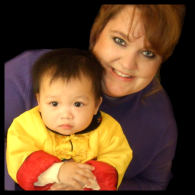This is an article that I found very, very interesting. We have all heard about attachment and the issues regarding this, but it hard to find out exactly what we as adoptive parent need to actually do to promote healthy attachment.
These are suggestions from therapists and parents of RAD kids
1. Wear infant in a chest carrier, all day if possible, facing IN.
2. Mom should initially be the only person who is meeting the baby's needs. Baby needs to build a bond with one person first, then she can branch out to others.
3. Bathe together, to promote skin to skin contact. Baby & Mom can wear the same lotion so baby associates scent with mom.
4. If you use cologne (or if you don't, use your shampoo), place a tiny bit on her arm so she has your smell with her at all times.
5. Laminate loving family pictures of you together and put around her crib and other places.
6. Outline her body, as well as your own on huge sheets of newsprint. Color them (great activity). Tape the "portraits" to her ceiling.
7. When feeding her something she particularly likes, tell her you are a good mommy/daddy. Telling her with words that you are a good mommy is important -- otherwise, how would she know?!
8. Play with dolls to act out how parents always return after child goes to day care, babysitter, bed, etc.
9. Draw cartoon panels of the day's routine, so that your child can see that Mom and Child always come back to the same home together. Anxiety and stress can interfere with auditory processing, so it is important to use something visual that can be held in the hand.
10. Give your child a laminated picture of the family to carry with her all the time.
11. Limit choices. At first parents should make all decisions, including foods, toys and clothes. This helps the child feel safe. Then as the child becomes accustomed to the new family, limited choices can be given, e.g. a choice between 2 foods.
12. Dress alike. Wear the same colors, type of outfit, accessories, hairstyle, etc. and point out how you look alike.
13. Claim your child. Tell her she belongs to you. Give her a big hug and say "MINE!" Make up songs about your family, e.g.:I am your MomYou're my sweet girlJust like a pearlso rare and preciousYou are mineand I am yours'Cause together we're a family.
Encourage Eye Contact
"Look in my eyes. Don't look away" - Mr. Soil from Bug's Life
1. Bottle feed no matter what the age. Encourage eye contact by gently touching her cheek. DO NOT let her hold the bottle. Nourishment has to come from parent(s); be sure to hold her when feeding.
2. If she turns away (avoiding eye contact) try placing a large mirror accross from you. That way, when she turns away, she will see herself in your embrace.
3. Continue to hold her in your gaze. It may take a long time for her to glance at you. When she finally does, be ready with a warm, loving, approving smile. This sounds little, but is really big and pays big rewards in our experience.
4. Encourage eye contact by gently tapping the bridge of her nose and yours as a hand-signal to look at you.
5. Stroke her cheek.
6. Put her hands on your cheeks. Children's eyes often go where their hands are.
7. Play Peek-a boo. This develops the concept of object permanence (that even if you can't see something, it's still there). For kids who are still anxious about Mommy leaving, repeat "Where's the Baby? Here's the Baby! Where's Mommy? Here's Mommy! Mommy goes to work, Mommy comes home!" to emphasize the message that Mommy always comes back.
8. Have baby pull a sticker off your nose - and put it back.
9. Wear a stick-on dot or earring as a "beauty mark."
10. Stare into each other's eyes. If your child can keep eye contact for 20 seconds, feed her a chocolate kiss or candy heart. Increase the amount of time.
11. MUSICAL NOSE - Sing a song and let your child pinch your nose so you sound very silly. You stop singing if she breaks eye contact.
12. MUSICAL SWING - put child in baby swing. Face her as you push. Encourage eye contact by singing a song, and stopping if she looks away.
13. Fill your cheeks with air. Have child "pop" them.
14. Take turns feeding each other. This works great with raisins, cheerios, and popcorn.
15. Eskimo kisses - rub noses and stare into each others eyes.
16. Play in front of a mirror. Make faces, paint Mommy's face, trace each other's faces on the mirror with washable marker, finger paint with shaving cream. Let your child be your puppet and make her dance. Make dolls dance. Any kind of game that gets your child to relax and meet your eyes in the mirror, will likely get her relaxed enough to meet your eyes directly.
17. Instead of using an actual mirror, take turns being each other's mirror. Sit face to face, and have your child imitate every facial movement you make, and vice versa. Then try it with your whole body, mirroring each other's movements.
18. For an older child, try lipreading with each other. While you're not really getting eye contact, you're at least looking at each other's faces.
Games which Encourage Attachment
1. Play hide and seek (also develops object permanence).
2. Play catch! Roll a ball back and forth (teaches reciprocity). Throwing or batting a balloon back and forth may be easier than throwing a ball for little ones.
3. Hold baby in your arms and dance with her. A very synchronous activity.
4. Swim together.
5. Paint each others faces with paint, power, or just pretend.
6. Put lotion on each other.
7. A Memory game but with a more personal touch: Have your child look you over very carefully. Then leave the room and return after you've changed something about yourself. See if she can figure out what is different. It could be something really obvious for younger kids, like taking off a sweater, but for older kids you could get more challenging, like buttoning one more button on the sweater.
8. Guess the Goodies: Put several small treats in a bag or cup. child closes their eyes. You pop a treat in their mouth and they try to guess what it is.
9. Tunnels: Parents kneel on floor forming a tunnel. Child crawls through the tunnel as fast as they can before the tunnel collapses. first few times let child get completely through, then have it gently collapse onto child.
10. Pillow ride: have child sit on big floor pillow and you drag them around the room. You only move when given eye contact.
11. M&M hockey: Use bendy straws and blow candy across table to other persons goal. When you score a goal, the opponent feeds you the candy.
12. Marshmallow fight: Each person uses a pillow as a shield. Sit on the floor and throw marshmallows at each other. Gets wild and crazy and is a lot of fun. Can do the same with crumpled paper.
13. Crawling into arms: Child starts in corner of room. Cannot start until adult says go. Start by saying "lo", "mo" etc. instead of "go" to help child learn to attend better. Then child crawls across room as fast as they can to you. You are standing on other side of room and make a large circle with arms. Child needs to stand up in the circle. gradually reduce the size of the circle and gets a big reward of kisses hugs and/or a treat.
14. Jumping across pillows to arms: set up pillow islands in a pattern across floor. Child starts at one end, you are at the other. Child starts when you direct them to as noted above. Child jumps across the islands and into your arms. Finding goodies. Hide candies on yourself and child needs to find them.
15. Donut Dare: You hold a donut on your finger through the hole and the child sees how many bites they can take before it falls off.
16. Lifesavers on Licorice String: Put each end of shoestring licorice in yours and childs mouth (helps to tie a knot so that it stays in mouth better). Have a gummy lifesaver on the string. By standing up and maneuvering without hands, feed the lifesavers to each other.
Sensory Activities
Mouth - to improve speech
1. Lots of bubble blowing.
2. Drinking with a straw, especially thick milkshakes.
3. Whistle blowing (I know, it can become irritating to mom real fast).
4. Party blowers -- the ones that un-curl and then curl back up again.
5. Provide different kinds of textures to move around -- both with his tongue and with his hands: baby peas, rice, couscous, puddings, jello. Paint a plate with chocolate pudding and then eating it off the plate and hands is fun -- although you might want to try a colored plate and vanilla pudding if your child is under two.
6. Wake up his taste buds -- sour candies like Sweet Tarts, chili, pepper, mustard, paprika, pickles -- anything with vinegar. Learning the sour taste is especially important.
7. Tapping very lightly above the upper lip above the gum line--but NOT on the midline.
8. Making "mouth music."
9. Tear tissue in small pieces or strips and blow it across the table top.
Tactile
One mom uses Creamy Style Vaseline, and makes lotion time an attachment activity time with these games:
1. Pass the lotion. Get lots of lotion on your hand and let your daughter try to get all of it off, and then pass it back and forth.
2. Slippy hands. After lotioning pretend to hold on tight to each others' hands and then "whoops" slip off backwards with lots of exageration and laughter.
3. Hand Stacking. Place your hand on the bottom, then one of your daughters, then yours, then your daughters. Slip your bottom hand out and put it on top. Just keep on going to "build the stack". Lotion painting. Paint pictures on eack other and then rub them in and start over.
These are suggestions from therapists and parents of RAD kids
1. Wear infant in a chest carrier, all day if possible, facing IN.
2. Mom should initially be the only person who is meeting the baby's needs. Baby needs to build a bond with one person first, then she can branch out to others.
3. Bathe together, to promote skin to skin contact. Baby & Mom can wear the same lotion so baby associates scent with mom.
4. If you use cologne (or if you don't, use your shampoo), place a tiny bit on her arm so she has your smell with her at all times.
5. Laminate loving family pictures of you together and put around her crib and other places.
6. Outline her body, as well as your own on huge sheets of newsprint. Color them (great activity). Tape the "portraits" to her ceiling.
7. When feeding her something she particularly likes, tell her you are a good mommy/daddy. Telling her with words that you are a good mommy is important -- otherwise, how would she know?!
8. Play with dolls to act out how parents always return after child goes to day care, babysitter, bed, etc.
9. Draw cartoon panels of the day's routine, so that your child can see that Mom and Child always come back to the same home together. Anxiety and stress can interfere with auditory processing, so it is important to use something visual that can be held in the hand.
10. Give your child a laminated picture of the family to carry with her all the time.
11. Limit choices. At first parents should make all decisions, including foods, toys and clothes. This helps the child feel safe. Then as the child becomes accustomed to the new family, limited choices can be given, e.g. a choice between 2 foods.
12. Dress alike. Wear the same colors, type of outfit, accessories, hairstyle, etc. and point out how you look alike.
13. Claim your child. Tell her she belongs to you. Give her a big hug and say "MINE!" Make up songs about your family, e.g.:I am your MomYou're my sweet girlJust like a pearlso rare and preciousYou are mineand I am yours'Cause together we're a family.
Encourage Eye Contact
"Look in my eyes. Don't look away" - Mr. Soil from Bug's Life
1. Bottle feed no matter what the age. Encourage eye contact by gently touching her cheek. DO NOT let her hold the bottle. Nourishment has to come from parent(s); be sure to hold her when feeding.
2. If she turns away (avoiding eye contact) try placing a large mirror accross from you. That way, when she turns away, she will see herself in your embrace.
3. Continue to hold her in your gaze. It may take a long time for her to glance at you. When she finally does, be ready with a warm, loving, approving smile. This sounds little, but is really big and pays big rewards in our experience.
4. Encourage eye contact by gently tapping the bridge of her nose and yours as a hand-signal to look at you.
5. Stroke her cheek.
6. Put her hands on your cheeks. Children's eyes often go where their hands are.
7. Play Peek-a boo. This develops the concept of object permanence (that even if you can't see something, it's still there). For kids who are still anxious about Mommy leaving, repeat "Where's the Baby? Here's the Baby! Where's Mommy? Here's Mommy! Mommy goes to work, Mommy comes home!" to emphasize the message that Mommy always comes back.
8. Have baby pull a sticker off your nose - and put it back.
9. Wear a stick-on dot or earring as a "beauty mark."
10. Stare into each other's eyes. If your child can keep eye contact for 20 seconds, feed her a chocolate kiss or candy heart. Increase the amount of time.
11. MUSICAL NOSE - Sing a song and let your child pinch your nose so you sound very silly. You stop singing if she breaks eye contact.
12. MUSICAL SWING - put child in baby swing. Face her as you push. Encourage eye contact by singing a song, and stopping if she looks away.
13. Fill your cheeks with air. Have child "pop" them.
14. Take turns feeding each other. This works great with raisins, cheerios, and popcorn.
15. Eskimo kisses - rub noses and stare into each others eyes.
16. Play in front of a mirror. Make faces, paint Mommy's face, trace each other's faces on the mirror with washable marker, finger paint with shaving cream. Let your child be your puppet and make her dance. Make dolls dance. Any kind of game that gets your child to relax and meet your eyes in the mirror, will likely get her relaxed enough to meet your eyes directly.
17. Instead of using an actual mirror, take turns being each other's mirror. Sit face to face, and have your child imitate every facial movement you make, and vice versa. Then try it with your whole body, mirroring each other's movements.
18. For an older child, try lipreading with each other. While you're not really getting eye contact, you're at least looking at each other's faces.
Games which Encourage Attachment
1. Play hide and seek (also develops object permanence).
2. Play catch! Roll a ball back and forth (teaches reciprocity). Throwing or batting a balloon back and forth may be easier than throwing a ball for little ones.
3. Hold baby in your arms and dance with her. A very synchronous activity.
4. Swim together.
5. Paint each others faces with paint, power, or just pretend.
6. Put lotion on each other.
7. A Memory game but with a more personal touch: Have your child look you over very carefully. Then leave the room and return after you've changed something about yourself. See if she can figure out what is different. It could be something really obvious for younger kids, like taking off a sweater, but for older kids you could get more challenging, like buttoning one more button on the sweater.
8. Guess the Goodies: Put several small treats in a bag or cup. child closes their eyes. You pop a treat in their mouth and they try to guess what it is.
9. Tunnels: Parents kneel on floor forming a tunnel. Child crawls through the tunnel as fast as they can before the tunnel collapses. first few times let child get completely through, then have it gently collapse onto child.
10. Pillow ride: have child sit on big floor pillow and you drag them around the room. You only move when given eye contact.
11. M&M hockey: Use bendy straws and blow candy across table to other persons goal. When you score a goal, the opponent feeds you the candy.
12. Marshmallow fight: Each person uses a pillow as a shield. Sit on the floor and throw marshmallows at each other. Gets wild and crazy and is a lot of fun. Can do the same with crumpled paper.
13. Crawling into arms: Child starts in corner of room. Cannot start until adult says go. Start by saying "lo", "mo" etc. instead of "go" to help child learn to attend better. Then child crawls across room as fast as they can to you. You are standing on other side of room and make a large circle with arms. Child needs to stand up in the circle. gradually reduce the size of the circle and gets a big reward of kisses hugs and/or a treat.
14. Jumping across pillows to arms: set up pillow islands in a pattern across floor. Child starts at one end, you are at the other. Child starts when you direct them to as noted above. Child jumps across the islands and into your arms. Finding goodies. Hide candies on yourself and child needs to find them.
15. Donut Dare: You hold a donut on your finger through the hole and the child sees how many bites they can take before it falls off.
16. Lifesavers on Licorice String: Put each end of shoestring licorice in yours and childs mouth (helps to tie a knot so that it stays in mouth better). Have a gummy lifesaver on the string. By standing up and maneuvering without hands, feed the lifesavers to each other.
Sensory Activities
Mouth - to improve speech
1. Lots of bubble blowing.
2. Drinking with a straw, especially thick milkshakes.
3. Whistle blowing (I know, it can become irritating to mom real fast).
4. Party blowers -- the ones that un-curl and then curl back up again.
5. Provide different kinds of textures to move around -- both with his tongue and with his hands: baby peas, rice, couscous, puddings, jello. Paint a plate with chocolate pudding and then eating it off the plate and hands is fun -- although you might want to try a colored plate and vanilla pudding if your child is under two.
6. Wake up his taste buds -- sour candies like Sweet Tarts, chili, pepper, mustard, paprika, pickles -- anything with vinegar. Learning the sour taste is especially important.
7. Tapping very lightly above the upper lip above the gum line--but NOT on the midline.
8. Making "mouth music."
9. Tear tissue in small pieces or strips and blow it across the table top.
Tactile
One mom uses Creamy Style Vaseline, and makes lotion time an attachment activity time with these games:
1. Pass the lotion. Get lots of lotion on your hand and let your daughter try to get all of it off, and then pass it back and forth.
2. Slippy hands. After lotioning pretend to hold on tight to each others' hands and then "whoops" slip off backwards with lots of exageration and laughter.
3. Hand Stacking. Place your hand on the bottom, then one of your daughters, then yours, then your daughters. Slip your bottom hand out and put it on top. Just keep on going to "build the stack". Lotion painting. Paint pictures on eack other and then rub them in and start over.






























































1 comment:
Great post! As a special education teacher I have done research on attachment distorters in adopted children and also do a lot of sensory motor activities with my students. You are right on and have giving me many great new ideas. Thanks and keep up the research you are going to make a great mother.
Post a Comment